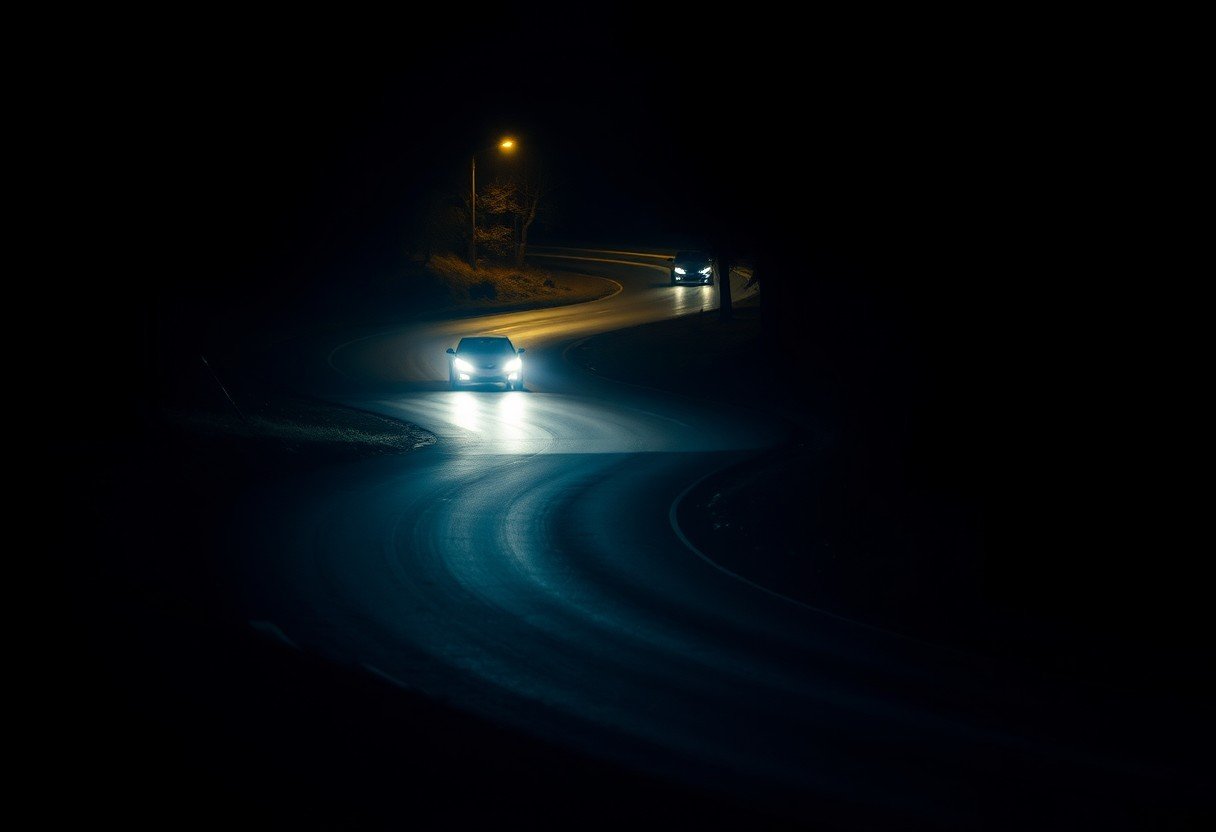Navigating curves while driving at night presents a unique set of challenges that demand a driver’s full attention. Reduced visibility and unexpected hazards can turn a simple bend into a dangerous situation. Understanding how to properly adjust your speed, use your headlights, and position your vehicle is not just good practice—it is essential for ensuring you and your passengers arrive safely at your destination. This guide will walk you through the key strategies for safely handling winding roads after dark.
Why are Curves More Dangerous at Night?
The fundamental challenge of nighttime driving is significantly reduced visibility. Your natural field of vision shrinks to the small area illuminated by your headlights, making it difficult to see the road ahead, read signs, or spot potential dangers like animals or debris.
This limited sight distance is compounded by other risk factors. According to the National Safety Council, traffic fatality rates are three times greater at night than during the day. This is due to a combination of lower visibility, driver fatigue, and a higher prevalence of impaired drivers on the road.
Risk management becomes your most important skill when driving on dark, curvy roads. It requires you to be constantly aware of your surroundings, anticipate potential changes, and adopt defensive driving habits to counteract the inherent dangers of low-light conditions.
Know the Road: Identifying Different Types of Curves
Not all curves are created equal, and recognizing the type of bend you are approaching is critical for navigating it safely. Road signs often provide clues, but at night, you may need to rely on the shape of the road revealed by your headlights to judge the curve’s severity.
Understanding these distinctions allows you to anticipate how much you need to slow down and how to adjust your steering. A gentle curve requires a minor adjustment, while a hairpin turn demands a significant reduction in speed and a sharp, controlled steering input.
| Curve Type | Description |
|---|---|
| Gentle Curves | Low degree of turning, easy to navigate |
| Sharp Bends | Requires drastic steering changes |
| Hairpin Turns | U-shaped, very tight turns |
| Elevation Changes | Curves accompanied by steep hills |
| Highway On/Off Ramps | Designed for merging and exiting highways |
Mastering the Curve: Essential Driving Techniques
Safely maneuvering through a curve at night depends on two key factors: your speed and your position in the lane. The most common mistake drivers make is entering a curve too fast, which can lead to losing traction and control of the vehicle.
The golden rule is to slow down *before* you enter the curve, not while you are in it. Braking within a turn can upset the vehicle’s balance and increase the risk of a skid. Approach the curve at a manageable speed, maintain it through the apex, and then gently accelerate as you straighten out on the exit.
Maintaining proper vehicle positioning is just as crucial. You should aim to keep your vehicle centered within your lane to create a buffer on either side. This gives you more room to react if you encounter an obstacle or if another vehicle drifts into your lane.
Here are some key actions for safe navigation:
- Look as far through the turn as your headlights will allow to anticipate the road’s path.
- Make smooth and deliberate steering movements instead of sudden, jerky motions.
- Avoid distractions like your phone or radio to keep your full attention on the road.
Let There Be Light: Using Your Headlights Effectively
Your headlights are your most important safety tool for night driving. Using them correctly can dramatically improve your ability to see the road ahead. Use your high beams whenever possible on unlit, empty roads to maximize your visibility around upcoming curves.
However, you must be considerate of other drivers. Always switch back to your low beams when you see an oncoming vehicle or are approaching another car from behind. The glare from high beams can temporarily blind other drivers, creating a dangerous situation for everyone.
Headlight maintenance is also non-negotiable. Dirty or oxidized headlight lenses can reduce light output by as much as 90%, severely limiting your visibility. Regularly clean your headlights and ensure they are properly aligned to illuminate the road effectively without blinding others.
Common Pitfalls to Avoid on Winding Roads
One of the biggest mistakes a driver can make is becoming overconfident, especially on roads they travel frequently. Just because you know a road well does not mean it is free of new or unexpected hazards, such as a fallen tree branch, a deer, or a patch of black ice.
Ignoring weather conditions is another serious error. Rain, fog, and ice drastically reduce tire traction and visibility, making curves much more treacherous. A turn you can easily take at 40 mph in dry conditions might require you to slow to 25 mph when the road is wet or icy.
Always check the weather forecast before heading out at night. If conditions are poor, give yourself extra travel time, reduce your speed significantly, and increase your following distance to allow for longer stopping times.
Frequently Asked Questions about Night Driving on Curves
Why is reducing speed before a curve at night so important?
Reducing your speed before a curve is crucial because limited visibility at night shortens your reaction time. A slower speed gives you more time to respond to unexpected obstacles and helps maintain vehicle control, reducing the risk of skidding or drifting out of your lane.
How can I improve my visibility while driving through curves at night?
To improve visibility, ensure your headlights are clean and properly aligned. Use your high beams on dark, empty roads to see further around the bend, but switch to low beams for oncoming traffic. Also, keep your windshield clean inside and out to prevent glare.
What should I do if my vehicle starts to skid in a curve?
If you start to skid, stay calm and do not slam on the brakes. Take your foot off the accelerator and gently steer in the direction you want the front of the car to go. Keep your movements smooth and avoid overcorrecting, which can make the skid worse.
Are some vehicles better or worse for handling curves at night?
Yes, vehicle type matters. Trucks and SUVs have a higher center of gravity, making them more susceptible to rollovers if a curve is taken too quickly. Drivers of these vehicles should be extra cautious and reduce their speed more than drivers in smaller cars.









Leave a Comment